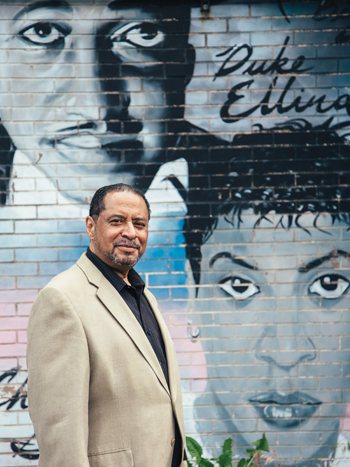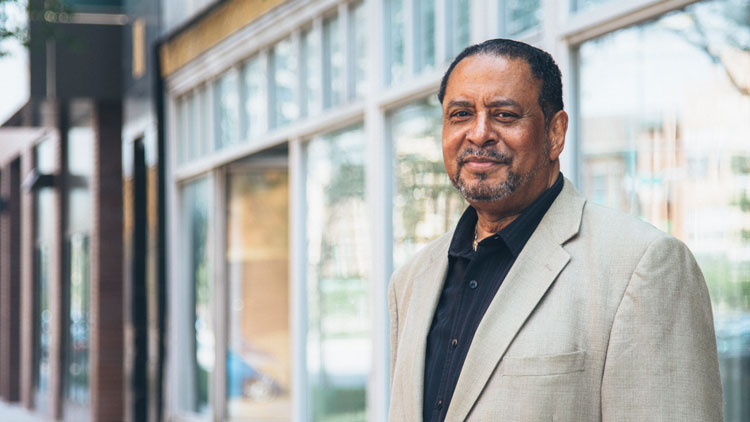In the early twentieth century, a four-block stretch of Chicago’s State Street from 31st to 35th streets was the place to be and to be seen. It was the heart of “The Stroll,” a vibrant cultural center of African-American nightlife that for a time reigned as America’s jazz capital. During the day, the larger neighborhood comprising “The Stroll”—Bronzeville—was a thriving and largely self-sufficient community anchored by churches and successful businesses such as Binga Bank, the city’s first African-American-owned bank, which was known as the “Wall Street” of the South Side.
Just to the west of 33rd and State, a forerunner of a different sort was quietly rising: Armour Institute of Technology, created in 1890 out of the Armour Mission by the Reverend Frank Gunsaulus, a man of faith, and Philip Danforth Armour Sr., a giant of industry. When Bronzeville was laying roots as a new Chicago community, Armour Institute had already graduated its first African-American chemical engineer and by all accounts, the first African-American in the country to receive a chemical engineering degree, Charles W. Pierce, who left his home in Texas to seek new opportunities in Chicago. How would this progressive school continue to form partnerships with residents of the new Bronzeville community?
A City in Flux
Bridge building projects across the Chicago River as well as increased use of the automobile opened up new areas on the city’s West Side and North Side, where people could now live and raise their families. The nineteenth-century wood-framed houses that dotted the South Side were in poor condition, and the big Victorian mansions that once were the homes to wealthy industrialists were now either abandoned or divided into apartments.
During World War I, fewer laborers came to the United States from Europe, and for this reason industrialists looked to the South for workers; at the same time, African Americans were leaving the South to seek opportunities in other regions of the country. Good rail connections between the Mississippi Delta communities and Chicago—the nation’s transportation hub—helped to create what came to be known as the Great Migration. According to the City of Chicago, the city’s African-American population grew nearly 150 percent from 1910 to 1920, reaching a population of 110,000 by 1920. The early 1920s marked a peak period in the history of Bronzeville, with community members making strides not only in music but also in the areas of politics, entrepreneurship, and business.
The trajectories of Bronzeville and its neighboring urban institution of higher education, however, soon changed sharply; the former began to spiral downward as the latter continued to expand and move forward.
Changes in Public Policy
Beginning in the 1940s, the Chicago Housing Authority (CHA) had begun erecting “residential towers” in primarily African-American neighborhoods throughout the city. This was a public-policy extension of racially restrictive covenants, which were in place from 1927 to 1948, and continued to limit African Americans in moving into other neighborhoods. Additionally, the police wereparticipating in selective enforcement of illicit activities and this, combined with economic segregation, further contributed to a living environment in Bronzeville in which both crime and poverty flourished.
Changes in such public policy fostered disenfranchisement and isolation among African Americans on the South Side. One notable example of this decline in Bronzeville housing was the once-vibrant Mecca Flats, which stood on the site of S. R. Crown Hall. Built in 1891, the Mecca was considered the epitome of a great apartment residence and attracted residents who reveled in its luxurious touches. By the 1920s it was a dilapidated tenement, its residents unable to move in part due to restrictive covenants and the economic devastation of the Great Depression.
Beginning in the late 1940s, Armour Institute, incorporated as Illinois Institute of Technology, razed buildings that were once the home to Bronzeville residents and businesses to expand the campus per Ludwig Mies van der Rohe’s master plan. Mecca Flats, one of the last to fall, was razed in 1952. Why didn’t Bronzeville’s residents turn against IIT when the university purchased large parcels of land in the community?
Expanding Campus Presence
University Archivist Ralph Pugh, who also teaches courses in Chicago history at IIT, says that there are several reasons why the university and Bronzeville survived this seminal period.
“Historic preservation was not foremost in the community’s mind,” he explains. “The African-American middle class and civic leaders left the area as soon as they could. Getting out of sub-standard housing was the goal of those who were left behind in these tenements. The center of Bronzeville had also moved away from IIT—slid past it from 35th and State to 47th Street. So in a sense, IIT was razing buildings and developing land no one in the community felt passionately about claiming.”
The period from the mid-1940s through the 1950s marked a golden age of growth and expansion for Main Campus from seven acres to 110 acres in part through the efforts of the South Side Planning Board, whose objective was to help revitalize and stabilize a seven-square-mile area that included Bronzeville. Board members included IIT and Michael Reese Hospital. Also, enforcing the power of eminent domain, the City of Chicago razed hundreds of buildings to construct the Dan Ryan Expressway. This latest effort at urban renewal and public works construction was a difficult time for many Bronzeville residents, however, who were relocated to Stateway Gardens and then to Robert Taylor Homes, the then-new CHA residential towers.

Photo: Scott Benbrook
In the late 1960s, after the death of Martin Luther King Jr., many universities located in or close to predominantly African-American communities started looking for ways to strengthen relationships with area residents and businesses with the goal of providing better campus environments for their students. Illinois Tech began to expand educational opportunities for underrepresented students across the city with novel initiatives such as the Early Identification Program and the Chicago Area Health and Medical Careers Program (CAHMCP, known as “Champs.”)“IIT benefited greatly during this time from the efforts of Nate Thomas, John Bradley, and Dr. Regnal ‘Reggie’ Jones,” says Leroy Kennedy, vice president of IIT’s Office of Community Affairs and Outreach Programs. “Thomas was instrumental in recruiting African Americans from across the country who wanted to earn engineering degrees to enroll in IIT. In the 1980s, Jones and Bradley, through Champs, which was housed at IIT, encouraged and mentored qualified African-American students to study pre-med in college and then apply for admission to medical school.”
A native South Sider and long-time community activist, Kennedy joined IIT in 1989. As one of his first outreach efforts he helped to organize the Mid-South Planning Group, a community initiative composed of foundation, corporate, civic, and government partners. The group developed the “Mid-South Strategic Development Plan: Restoring Bronzeville,” a blueprint for land use in Bronzeville for the next 20 years. As a result, the Mid-South Planning and Development Commission was formed to help implement the plan’s recommendations—a key one being a “better integration of IIT into the neighborhood.”
A Community’s Continued Renewal
IIT took other lead roles in creating new coalitions designed to strengthen a sense of community. Kennedy became involved in the South Side Partnership, for example, helping to strengthen and unify community and institutional interests. The group worked to support local educational improvements and was instrumental in connecting South Side communities to the resources of the partner organizations that were interested in serving the area, which included IIT, the Chicago Urban League, Centers for New Horizons, and others.
During the 1990s and 2000s, changes took place to help rebuild Bronzeville. The university worked with the Home Builders Association of Greater Chicago to sponsor the country’s first urban Parade of Homes, proving that market-rate housing was viable and profitable in Bronzeville.
The collaborative Black Metropolis Historic District initiative focused on the historic preservation of remaining Bronzeville structures and heritage tourism to drive economic development, a strategy that complemented IIT’s intentions to upgrade campus buildings and their landscape. The initiative was a public-private partnership whose membership included local civic and government leaders as well as university representatives. Kennedy has also worked to have a large span of area including Bronzeville designated as a National Heritage Area and is in the final stage of talks with the National Park Service on this potential designation.
By 2000 construction was completed on the new headquarters of the Chicago Police Department—the most technologically advanced police facility in the country—now located at the corner of 35th and Michigan Avenue. During this same period, the CHA’s Stateway Gardens public housing high-rises located at 35th and State were being demolished; by 2007 they were replaced with Park Boulevard, a mixed-income housing and business development, complete with a Starbucks coffee shop. IIT worked with the City of Chicago and the CHA in the early stages of the Plan for Transformation, an initiative to redevelop the city’s public housing beginning in 2000.
IIT also partnered with Perspectives Charter Schools to open Perspectives/IIT Math & Science Academy, a STEM-focused middle school and high school, at 36th and Wabash in 2008. The newest community outreach program is Parent University [see sidebar], which is designed to guide parents and guardians of middle and high school students through the college preparatory and admission process.
Partnering for the Future
IIT continues to seek ways to provide educational opportunities for residents of Bronzeville and the greater South Side community, but collaborative work still needs to be done in other areas as well, such as finding ways to reduce crime, further revitalize commercial development, and create more jobs for locally, minority-, and women-owned businesses.
“The attitudes and actions that can limit progress and destroy these hard-won gains or weaken our sense of shared community are retrenchment, isolation, an attitude that all is well, and lack of engagement—economic, academic, social, and cultural as well as philosophical,” says Kennedy. “An active citizenry creates a balanced growth environment and is accountable. The environment is not defined or based on race, economics, political partisanship, or cultural identity, but on a shared sense of community based on enlightened self-interest. That is the path IIT and Bronzeville need to keep walking—and we need to keep walking it together.”
